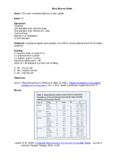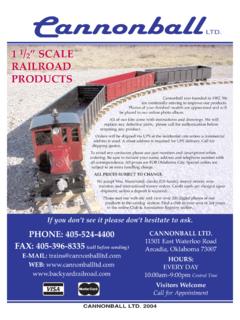Transcription of The NSGCD Clutter Hoarding Scale - Children of Hoarders
1 The NSGCD Clutter Hoarding Scale Official Organizational Assessment Tool Copyright 2003 NSGCD . It is permissible to reprint these materials as long as they remain intact and reprinted in their entirety to ensure that the Tool s objectives are substantially understood. For our research and study, we respectfully request that you inform us if you are using this Tool for educational purposes. Email: or call: 314-416-2236. NSGCD 2003 Clutter - Hoarding Scale Copyright 2003 Published by National Study Group on Chronic Disorganization 4728 Hedgemont Drive St. Louis, MO 63128 Publication Number 016 Facilitated by Terry Prince All rights reserved by NSGCD .
2 No part of this document may be reproduced or transmitted in any form by any means without the written permission of the publisher, except where permitted by law. The opinions expressed in this publication are those of individuals, not necessarily the National Study Group on Chronic Disorganization. This document is to be used as an assessment/guideline tool only. The National Study Group on Chronic Disorganization is not responsible for any work performed by a Professional organizer or other related professional when using the NSGCD Clutter - Hoarding Scale . NSGCD 2003 Clutter - Hoarding Scale The NSGCD Clutter - Hoarding Scale A Study Guide for Professional Organizers and Related Professionals CONTENTS PURPOSE OF THE Scale 1 PARAMETERS OF THE LEVELS 1 FUTURE PROJECTS 2 NSGCD Clutter - Hoarding Scale 3 NSGCD 2003 Clutter - Hoarding Scale PURPOSE OF THE Scale The purpose of the NSGCD Clutter - Hoarding Scale is to guide professional organizers1 and related professionals in their initial, pre-session contact (phone or onsite) or first session assessment work.
3 This Scale is primarily based on the interior of a home, except where the outside structure affects the overall safety of the interior, as indicated. It does not include sheds and unattached garages or outbuildings. The NSGCD Clutter - Hoarding Scale is an assessment measurement tool developed by the National Study Group on Chronic Disorganization ( NSGCD ) to give professional organizers and related professionals definitive parameters. These parameters relate to health and safety issues and present a potential range in which professional organizers and related professionals may actually choose to work. The NSGCD is a Non-profit 501C3 educational organization whose mission is to educate professional organizers and related professionals on the issues relating to Chronic Disorganization.
4 This Scale was publicly released in October 2003. Individuals or agencies quoting Levels as listed on this chart should list the NSGCD as the creating organization. Developers of this Clutter - Hoarding Scale are NSGCD members Sheila Delson, Cindy Glovinsky, Terry Prince and Heidi Schultz PARAMETERS OF THE LEVELS NSGCD has established five levels to indicate the degree of household Clutter and Hoarding from a professional organizer s2 and related professional s perspective: Level I is low; Level IV is high. Within each level there are four specific categories which define the severity of Clutter and Hoarding potential: Structure and zoning3; Pets and rodents; Household functions; Sanitation and cleanliness.
5 1 A professional organizer is an organizer who receives remuneration for organizing services, maintains professional standards and ethics defined by association affiliations, and continually educates him or herself in the organizing field and /or specialty areas. 2 A professional organizer s perspective includes understanding animal regulations and ordinances, building and zoning safety guidelines, general health and safety guidelines, as well as the degree of Clutter . 3 When dealing with structural issues, a professional organizer needs to know if client is tenant or owner. Owner is responsible for many items under federal, state and local housing codes.
6 Tenant may be hesitant to call owner for repairs due to excessive Clutter . 1 NSGCD 2003 Clutter - Hoarding Scale One problem found in any of these four categories may indicate the need for further investigation regarding the whole level. Level I. Household is considered standard. No special knowledge in working with the Chronically Disorganized is necessary. Level II. Household requires professional organizers or related professionals to have additional knowledge and understanding of Chronic Disorganization. Level III. Household may require services in addition to those a professional organizer and related professional can provide.
7 Professional organizers and related professionals working with Level III households should have significant training in Chronic Disorganization and have developed a helpful community network of resources, especially mental health providers. Level IV. Household needs the help of a professional organizer and a coordinated team of service providers. Psychological, medical issues or financial hardships are generally involved. Resources will be necessary to bring a household to a functional level. These services may include pest control services, "crime scene cleaners," financial counseling and licensed contractors and handypersons.
8 Level V. Household will require intervention from a wide range of agencies. Professional organizers should not venture directly into working solo with this type of household. The Level V household may be under the care of a conservator or be an inherited estate of a mentally ill individual. Assistance is needed from many sources. A team needs to be assembled. Members of the team should be identified before beginning additional work. These members may include social services and psychological/mental health representative (not applicable if inherited estate), conservator/trustee, building and zoning, fire and safety, landlord, legal aid and/or legal representatives.
9 A written strategy needs to be outlined and contractual agreements made before proceeding. FUTURE PROJECTS The NSGCD will work to develop recommended guidelines for working with Level III V clients and households. These guidelines will include project management strategies for the professional organizer, collaborative therapy recommendations, compliance and managing government agency regulations and reporting requirements, as well as organizational techniques. 2 NSGCD 2003 Clutter - Hoarding Scale NSGCD Clutter - Hoarding Scale Level Structure & Zoning Issues Pets & Rodents Household Functions Sanitation & Cleanliness I All doors and stairways accessible Normal household pet activity 1 3 spills or pet accidents evident Light evidence of rodents/insects Clutter not excessive Normal housekeeping Safe and healthy sanitation No odors II 1 exit blocked 1 major appliance or regionally appropriate heating.
10 Cooling or ventilation device not working for longer than 6 months Some pet odor Cat spray or pet waste puddles Light pet dander in evidence 3 or more incidents of feces in cat box Limited fish, reptile or bird pet care Light-to-medium evidence of common household rodents/insects Clutter inhibits use of more than two rooms Unclear functions of living room, bedroom Slight narrowing of household pathways Limited evidence of housekeeping, vacuuming, sweeping Tolerable, but not pleasant, odors Overflowing garbage cans Light to-medium mildew in bathroom or kitchen Moderately soiled food preparation surfaces 3 NSGCD 2003 Clutter - Hoarding Scale Level Structure & Zoning Issues Pets & Rodents Household Functions Sanitation & Cleanliness III Visible Clutter outdoors Items normally stored indoors evident outside (TV, sofa) 2 or more appliances broken or not functioning Inappropriate and/or excessive use of electric and extension cords Light structural damage limited to 1 part of home.







